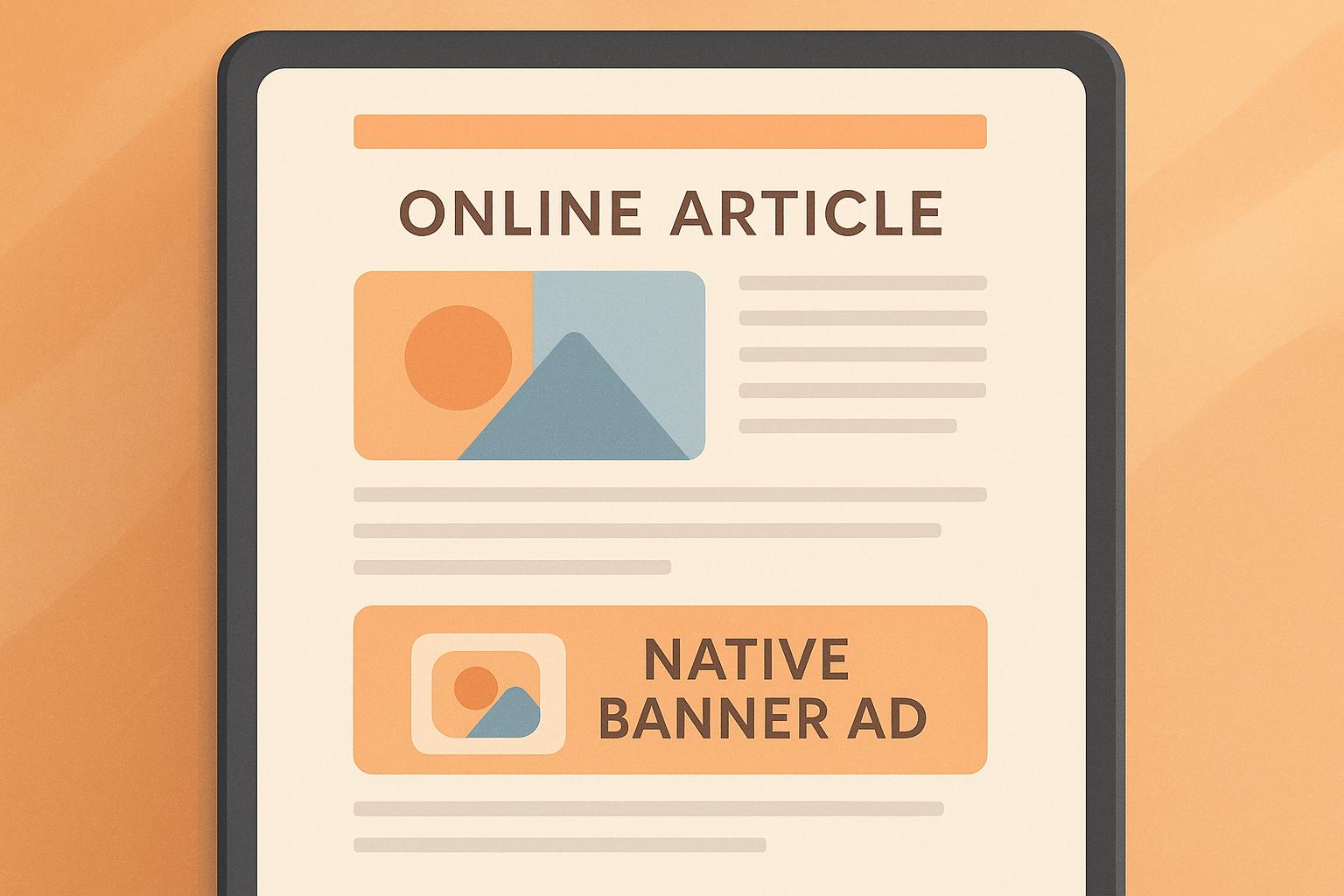


Native banner ads integrate seamlessly into content, enhancing user experience and engagement compared to disruptive display ads.
Native banner ads outperform display ads because they integrate smoothly into the content of a platform, offering a less disruptive experience. Unlike display ads, which rely on bold visuals to grab attention, native ads match the style and tone of the surrounding content. This makes them more appealing to developers, who often avoid intrusive formats. Key points include:
- User Experience: Native ads are less intrusive and align with the platform’s design, while display ads can disrupt browsing.
- Engagement: Native ads achieve higher click-through rates due to their relevance and alignment with user intent.
- Trust: Developers are more likely to engage with ads that feel relevant and natural, making native ads more effective.
- Ad Blockers: Native ads are less likely to be blocked compared to display ads.
For businesses targeting developers, native banner ads provide better engagement and return on investment by aligning with the audience’s preferences and workflows.
Quick Comparison
| Criteria | Native Ads | Display Ads |
|---|---|---|
| Design | Blends with platform design | Stands out with bold visuals |
| User Experience | Non-disruptive | Can interrupt browsing |
| Engagement | Higher click-through rates | Often ignored due to "banner blindness" |
| Ad Blocker Impact | Less likely to be blocked | Frequently blocked |
| ROI | Better long-term engagement | Effective for broad brand awareness |
For developer-focused campaigns, native ads are the better choice for building connections and driving meaningful results.
1. Native Banner Ads
Design and Integration
Native banner ads are designed to blend effortlessly into a platform’s look and feel. By mirroring the fonts, colors, and layout of the site, these ads appear as a natural part of the content. For instance, an ad promoting a new API tool might sit alongside posts about backend development, using technical terms and language that resonate with developers. This design approach ensures the ad feels like an organic part of the platform.
User Experience
What sets native banner ads apart is how they enhance the browsing experience rather than disrupt it. They provide information in a way that feels more like education than promotion. Developers often visit platforms to discover new tools, trends, and best practices. Native banners align with these expectations, adding value to the reading experience instead of detracting from it.
Engagement Metrics
By fitting naturally into the platform, native banner ads maintain the flow of browsing and encourage users to engage more deeply. Their relevance to the surrounding content makes developers more likely to click through and explore further, effectively boosting engagement and interaction.
Return on Investment (ROI)
This increased engagement translates into higher-quality traffic and better conversions. Over time, native banner ads help build brand recognition and trust among developers. Their non-intrusive nature makes them a smart choice for advertisers looking to create lasting connections with their audience while achieving strong results.
2. Display Ads
Design and Integration
Display ads take a bold approach compared to native banner ads, intentionally standing out from the surrounding content. They often feature bright colors, striking graphics, and animations, typically placed in banners, sidebars, or pop-ups.
For developer audiences, this stark contrast can feel jarring. Imagine a flashy banner promoting a consumer product sitting next to a technical article about API development or coding frameworks - it feels out of place. Display ads rely on grabbing attention through visual disruption, but this clashes with the focused, information-driven mindset of developers browsing technical content. Unlike native ads, which blend seamlessly into their environment, display ads thrive on being noticeable, sometimes at the expense of user harmony.
User Experience
When it comes to user experience, display ads often face criticism, especially from professional audiences like developers. These ads can interrupt the natural flow of reading and learning, slowing down page load times and breaking concentration.
Developers, in particular, are known for their aversion to intrusive ad formats. Many in the tech world are searching for tools, reading documentation, or staying current on trends, and interruptions only derail their efforts. This explains why these audiences are especially resistant to ads that disrupt their workflow.
Engagement Metrics
One of the biggest hurdles for display ads is overcoming “banner blindness.” Users have become so accustomed to ignoring obvious advertising cues that even the most well-crafted display ads often go unnoticed. Click-through rates tend to be low, reflecting this challenge.
That said, some strategies can improve outcomes. For instance, retargeted display ads can increase conversions by up to 70% and garner 53% more views than standard display ads. Additionally, leveraging AI-powered tools for ad optimization has shown impressive results - JPMorgan Chase reported up to a 450% increase in CTR with AI-enhanced ad copy. While engagement remains a challenge, these tactics show that thoughtful execution can still yield results.
Return on Investment (ROI)
Display ads are often more effective for building brand awareness than driving immediate conversions, especially in the B2B space where developers are a key audience. Many professionals in this group express skepticism about the direct impact of display ads on their purchasing decisions or lead generation. The situation worsens when ads disrupt content flow, load slowly, or appear too frequently, prompting users to either ignore them or resort to ad blockers.
Still, when executed with strong branding and precise targeting, display ads can leave a lasting impression. In fact, ads with clear branding have been shown to increase effectiveness by over 50%. While they may not drive clicks instantly, they can contribute to long-term brand recognition, which is valuable in its own right.
Native Ads vs. Display Ads: Which Are Better?
sbb-itb-e54ba74
Pros and Cons
To fine-tune your advertising strategy, it’s crucial to weigh the strengths and weaknesses of native banner ads and display ads. Each format comes with its own set of tradeoffs, and understanding them can help you align your approach with your goals. Here’s a breakdown of how these two options compare across key criteria:
| Criteria | Native Banner Ads | Display Ads |
|---|---|---|
| Design Integration | Pros: Seamlessly blends with content, creating a more natural user experience. Cons: May be less noticeable and requires thoughtful design to stand out effectively. |
Pros: High visibility, helping to boost brand presence. Cons: Can feel intrusive, clash with technical content, and disrupt the natural flow of reading. |
| User Experience | Pros: Non-disruptive and reduces ad fatigue - qualities appreciated by developer audiences. Cons: Lower immediate brand recall, requiring more impressions to build awareness. |
Pros: Clear and direct brand messaging. Cons: Often suffers from banner blindness and can slow down page load times. |
| Engagement | Pros: Higher click-through rates with less interference from ad blockers. Cons: Engagement tends to be subtle, making it harder to measure immediate brand impact. |
Pros: When optimized, can drive strong engagement in the right context. Cons: Banner blindness and lower baseline engagement are common challenges. |
| ROI & Performance | Pros: Delivers long-term engagement and high-quality conversions, ideal for targeting developers. Cons: Tracking immediate brand impact can be tricky and may require longer attribution windows. |
Pros: Effective for broad brand awareness with measurable impressions. Cons: Lower direct conversion rates, higher ad blocker usage, and skepticism from technical audiences. |
| Targeting Precision | Pros: Contextually relevant, aligns with user intent, and works well for niche developer segments. Cons: Limited to content-appropriate placements, with fewer creative format options. |
Pros: Flexible placement options across various website sections and supports rich media formats. Cons: Less contextually relevant and may appear in unsuitable environments. |
When deciding between these formats, it’s all about your campaign’s objectives. Native banner ads are a strong choice for building trust and engaging developer audiences without interrupting their workflow. Platforms like daily.dev Ads are particularly suited for this, as they cater to users who value relevant, unobtrusive content that complements their browsing experience.
On the other hand, display ads - despite some challenges with developer audiences - can still play an important role in broader marketing efforts. They shine in brand awareness campaigns, especially when combined with precise targeting and smart optimization. Keep in mind that developer audiences often have different expectations and a lower tolerance for intrusive advertising compared to general consumer markets.
This comparison lays the groundwork for understanding which format aligns best with your advertising goals.
Conclusion
Native banner ads consistently outperform display ads in key metrics important to developers. They boast higher click-through rates, foster better engagement, and build trust with technical audiences who appreciate advertising that feels relevant and non-intrusive.
Research highlights that native banner ads achieve a 52% higher view rate and deliver a stronger brand lift. They’re also effective at driving engagement and producing qualified leads. For example, one developer forum reported a 40% increase in CTR and a 25% boost in user retention when using native banners.
Trust plays a crucial role in developer marketing, and native banner ads excel in this area by offering content that blends naturally into the platform while remaining clearly labeled. This approach resonates with developers who value transparency.
For advertisers seeking to optimize campaigns on developer platforms, the takeaway is clear: prioritize native banner ads. Focus on creating ads that seamlessly align with the platform’s design and provide meaningful value to the developer audience. Platforms like daily.dev Ads are perfectly positioned for this, offering native ad placements that connect with over 1 million developers worldwide, all while maintaining the non-disruptive experience developers prefer.
The key to success lies in delivering contextually relevant content, ensuring smooth integration, and maintaining transparency. By aligning your native banner ads with developers’ interests and workflows, you can achieve higher engagement, stronger trust, and better ROI - making native advertising the go-to choice for developer-focused campaigns.
FAQs
Why do native banner ads perform better at matching user intent compared to display ads?
Native banner ads tend to outperform traditional display ads because they blend effortlessly with the platform's content. By mirroring the style and tone of the surrounding material, these ads feel more organic and less disruptive, making them more appealing to users.
What sets native ads apart is their ability to grab attention and encourage interaction. Research shows that users are significantly more likely to engage with native ads than with standard display ads. This heightened engagement often translates into better click-through rates, improved brand recognition, and a stronger likelihood of purchase. The key? Native ads align closely with what users are already interested in or searching for, making them feel relevant and timely.
How can businesses make their native banner ads feel natural and integrated with platform content?
To create native banner ads that fit effortlessly into a platform's content, businesses should ensure the design, tone, and style of their ads align with the platform's aesthetic. This involves using similar color schemes, fonts, and layouts so the ad feels like a natural part of the environment.
Matching the tone and writing style of the platform's editorial content also helps the ad appear more integrated and less intrusive. At the same time, it's crucial to clearly label ads as sponsored content to maintain transparency and build trust with users. Lastly, prioritize relevant, non-disruptive content that resonates with the audience and adds value, which can lead to better engagement and a smoother user experience.
Why are native banner ads less likely to be blocked by ad blockers than traditional display ads?
Native banner ads are crafted to fit naturally within the content they appear alongside, making them less disruptive and more appealing to users. By mirroring the platform's layout and design, these ads are also less likely to be detected and blocked by ad blockers.
What sets native ads apart is their emphasis on enhancing the user experience. They align with the tone and format of the surrounding content, which helps them avoid being perceived as intrusive or disruptive. This thoughtful approach ensures the ads feel like a natural part of the platform.






